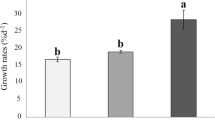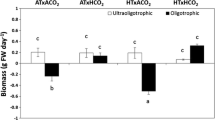Abstract
The ecological consequences of ocean acidification are unclear due to varying physiological properties of macroalgae and species-specific responses. Therefore, in the present study, we used a laboratory culture experiment to analyse the eco-physiological responses of the Mediterranean subtidal red alga Peyssonnelia squamaria to CO2-induced lower pH. Our results showed an increase in the photosynthetic performance and growth rate of P. squamaria, despite the reduction in CaCO3 content in the low pH treatment. According to our results, we believe that samples exposed to elevated CO2 could be regulated own nitrogen metabolism to support increased growth rate and it may be down-regulated nitrate uptake. As a result, we hypothesize that P. squamaria may benefit from ocean acidification.
Similar content being viewed by others
References
Beardal J, Beer S, Raven JA (1998) Biodiversity of marine plants in an era of climate change: some predictions based on physiological performance. Bot Mar 41:113–123
Beer S, Eshel A (1985) Determining phycoerythrin and phycocyanin concentrations in aqueous crude extracts of red algae. Aust J Mar Fresh Res 36:785–792
Bilan MI, Usov AI (2001) Polysaccharides of calcareous algae and their effect on the calcification process. Russ J Bioorg Chem 27(1): 2–16
Bischof K, Hanelt D, Wiencke C (1999) Acclimation of maximal quantum yield of photosynthesis in the brown alga Alaria esculenta under high light and UV radiation. Plant Biol 1:435–444
Bradford MM (1976) A rapid and sensitive method for the quantitation of microgram quantities of protein utilizing the principle of protein-dye binding. Anal Biochem 72(1–2):248–254
Calderia K, Wickett EM (2003) Oceanography: anthropogenic carbon and ocean pH. Nature 425:365
Celis-Pla PSM, Martinez B, Korbee N, Hal-Spencer JM, Figueroa FL (2017) Ecophysiological responses to elevated CO2 and temperature in Cystoseira tamariscifolia (Phaeophycea). Climatic Change 142:67–81
Chapman ARO, Craigie JS (1977) Seasonal growth in Laminaria longicruris: relations with dissolved inorganic nutrients and internal reserves of nitrogen. Mar Biol 40:197–205
Chisholm JRM (2003) Primary productivity of reef-building crustose coralline algae. Limnol Oceanogr 48(4): 1376–1387
Ciais P, Sabine C (2013) Carbon and other biogeochemical cycles. In: Stocker TF, Qin D, Plattner G-K, Tignor M, Allen SK, Boschung J, Nauels A, Xia Y, Bex V, Midgley PM (eds) Climate Change 2013: the physical science basis. Contribution of Working Group I to the Fifth Assessment Report of the Intergovernmental Panel on Climate Change, pp 465–570
Comeau S, Carpenter RC, Lantz CA, Edmunds PJ (2015) Ocean acidification accelerates dissolution of experimental coral reef communities. Biogeosciences 12:365–372
Cornwall CE, Revill AT, Hall-Spencer JM, Milazzo M, Raven JA, Hurd CL (2017) Inorganic carbon physiology underpins macroalgal responses to elevated CO2. Sci Rep 7:46297
Corzo A, Niell FX (1991) Determination of nitrate reductase activity in Ulva rigida C. Agardh by the in situ method. Exp Mar Biol Ecol 146:181–191
Dutra E, Koch M, Peach K, Manfrino C (2016) Tropical crustose coralline algal individual and community responses to elevated pCO2 under high and low irradiance. ICES J Mar Sci 73(3): 803–813
Eilers PHC, Peeters JCH (1988) A model for the relationship between light intensity and the rate of photosynthesis in phytoplankton. Ecol Model 42:199–215
Falkowski PG, Raven JA (2007) Aquatic photosynthesis. Princeton University Press, Princeton, 484 p
Fernandez PA, Roleda MY, Hurd CL (2015) Effects of ocean acdification on the photosynthetic performance, carbonic anhydrase activity and growth of the giant kelp Macrocystis pyrifera. Photosynth Res 124(3): 293–304
Fernandez PA, Roleda MY, Leal PP, Hurd CL (2017) Seawater pH, and not inorganic nitrogen source, affects pH at the blade surface of Macrocystis pyrifera: implications for responses of the giant kelp to future oceanic conditions. Physiol Plantarum 159:107–119
Flynn KJ, Blackford JC, Baird ME, Raven JA, Clark DR, Beardall J, Brownlee C, Fabian H, Wheeler GL (2012) Changes in pH at the exterior surface of plankton with ocean acidification. Nat Clim Change 2:510–513
Fujita K, Hikami M, Suzuki A, Kuroyanagi A, Sakai K, Kawahata H, Nojiri Y (2011) Effects of ocean acidification on calcification of symbiont-bearing reef foraminifers. Biogeosciences 8:2089–2098
Gao K, Aruga Y, Asada K, Kiyohara M (1993) Influence of enhanced CO2 on growth and photosynthesis of the red algae Gracilaria sp. and G. chilensis. J Appl Phycol 5:563–571
Gattuso JP, Allemand D, Frankingnoulle M (1999) Photosynthesis and calcification at cellular, organismal and community levels in coral reefs: a review on interactions and control by carbonate chemistry. Am Zool 39:160–183
Giordano M, Beardall J, Raven JA (2005) CO2 concentrating mechanisms in algae: mechanisms, environmental modulation, and evolution. Annu Rev Plant Biol 56:99–131
Gordillo FJL, Xavier N, Figueroa FL (2001) Non-photosynthetic enhancement of growth by high CO2 level in the nitrophilic seaweed Ulva rigida C. Agardh (Chlorophyta). Planta 213:64–70
Hofmann LC, Straub S, Bischof K (2013) Elevated CO2 levels affect the activity of nitrate reductase and carbonic anhydrase in the calcifying rhodophyte Corallina officinalis. J Exp Bot 64(4): 899–908
Hofmann LC, Bischof K (2014) Ocean acidification effects on calcifying macroalgae. Aquat Biol 22:261–279
Hurd CL, Harrison PJ, Bischof K, Lobban CS (2014) Seaweed ecology and physiology. Cambridge University Press, Cambridge, 562 p
Iniguez C, Heinrich S, Harms L, Gordillo FJL (2017) Increased temperature and CO2 alleviate photoinhibition in Desmarestia anceps: from transcriptomics to carbon utilization. J Exp Bot 68(14): 3971–3984
Inskeep PW, Bloom RP (1985) Extinction coefficients of chlorophyll a and b in N, N-Dimethyformamide and 80% Acetone. Plant Physiol 77(2): 483–485
IPCC (2014) Climate Change 2014: synthesis report. Contribution of Working Groups I, II and III to the Fifth Assessment Report of the Intergovernmental Panel on Climate Change. IPCC, Geneva, 151 p
Israel A, Hophy M (2002) Growth, photosynthetic properties and Rubisco activities and amounts of marine macroalgae grown under current and elevated seawater CO2 concentrations. Glob Change Biol 8(9): 831–840
Johnson VR, Russell BD, Fabricius KE, Brownlee C, Hall-Spencer JM (2012) Temperate and tropical brown macroalgae thrive, despite decalcification, along natural CO2 gradients. Glob Change Biol 18:2792–2803
Kang JW, Kambey C, Shen Z, Yang Y, Chung IK (2017) The shortterm effects of elevated CO2 and ammonium concentrations on physiological responses in Gracilariopsis lemaneiformis (Rhodophyta). Fish Aquatic Sci 20:10–18
Kim JH, Kang EJ, Edwards MS, Lee K, Jeong HJ, Kim KY (2016) Species-specific responses of temperate macroalgae with different photosynthetic strategies to ocean acidification: a mesocosm study. Algae 31(3): 243–256
Koch M, Bowes G, Ross C, Zhang XH (2013) Climate change and ocean acidification effects on seagrass and marine macroalgae. Glob Change Biol 19:103–132
Kram SL, Price NN, Donham EM, Johnson MD, Kelly ELA, Hamilton SL, Smith JE (2016) Variable responses of temperate calcified and fleshy macroalgae to elevated pCO2 and warming. ICES J Mar Sci 73(3): 693–703
Kübler JE, Dudgeon SR (2015) Predicting effects of ocean acidification and warming on algae lacking carbon concentrating mechanisms. PLoS One 10(7):e0132806
Kübler JE, Johnston AM, Raven JA (1999) The effects of reduced and elevated CO2 and O2 on the seaweed Lomentaria articulata. Plant Cell Environ 22:1303–1310
Kübler JE, Raven JA (1994) Consequences of light limitation for carbon acquisition in three rhodophytes. Mar Ecol-Prog Ser 110:203–209
Lavoie M, Faucheur SL, Boullemant A, Fortin C, Campbell PGC (2012) The influence of pH on algal cell membrane permeability and its implications for the uptake of liphophilic metal complexes. J Phycol 48(2): 293–302
Linares C, Vidal M, Canals M, Kersting DK, Amblas D, Aspillaga E, Cebrián E, Delgado-Huertas A, Díaz D, Garrabou J, Hereu B, Navarro L, Teixidó N, Ballesteros E (2015) Persistent natural acidification drives major distribution shifts in marine benthic ecosystems. P Roy Soc B-Biol Sci 282:20150587
Liu C, Zou D (2015) Responses of elevated CO2 on photosynthesis and nitrogen metabolism in Ulva lactuca (Chlorophyta) at different temperature levels. Mar Biol Res 11:1043–1052
Nash MC, Opdyke BN, Troitzsch U, Russell BD, Adey WH, Kato A, Diaz-Pulido G, Brent C, Gardner M, Prichard J, Kline DI (2012) Dolomite-rich coralline algae in reefs resist dissolution in acidified conditions. Nat Clim Change 3:268–272
Orr JC, Fabry VJ, Aumont O, Bopp L, Doney SC, Feely RA, Gnanadesikan A, Gruber N, Ishida A, Joos F, Key RM, Lindsay K, Maier-Reimer E, Matear R, Monfray P, Mouchet A, Najjar RG, Plattner G-K, Rodgers KB, Sabine CL, Sarmiento JL, Schlitzer R, Slater RD, Totterdell IJ, Weirig M-F, Yamanaka Y, Yool A (2005) Anthropogenic ocean acidification over the twenty-first century and its impact on calcifying organisms. Nature 437(29): 681–686
Padilla-Gamino JL, Gaitan-Espitia JD, Kelly MW, Hofmann GE (2016) Physiological plasticity and local adaptation to elevated pCO2 in calcareous algae: an ontogenic and geographic approach. Evol Appl 9:1043–1053
Pajusalu L, Martin G, Paalme T, Pollumae A (2016) The effect of CO2 enrichment on net photosynthesis of the red alga Furcellaria lumbricalis in a brackish water environment. Peer J 4:e2505
Porzio L, Buia MC, Hall-Spencer JM (2011) Effects of ocean acidification on macroalgal communities. J Exp Mar Biol Ecol 400:278–287
Pritchard DW, Hurd CL, Beardall J, Hepburn CD (2015) Restricted use of nitrate and a strong preference for ammonium reflects the nitrogen ecophysiology of a light limited red alga. J Phycol 51:277–287
Provasoli L (1968) Media and prospects for the cultivation of marine algae. In: Proceedings of the US-Japan Conference, Japanese Society of Plant Physiology, Hakone, 12–15 September 1966, pp 63–75
Ries JB, Cohen AL, Mccorkle DC (2009) Marine calcifiers exhibit mixed responses to CO2-inducedocean acidification. Geology 37:1131–1134
Roleda MY, Boyd PW, Hurd CL (2012) Before ocean acidification: calcifier chemistry lessons. J Phycol 48:840–843
Schulz KG, Barcelose-Ramos J, Zeebe RE, Riebesell U (2009) CO2 perturbation experiments: similarities and differences between dissolved inorganic carbon and total alkalinity manipulations. Biogeosciences 6:2145–2153
Semesi IS, Kangwe J, Björk M (2009) Alterations in seawater pH and CO2 affect calcification and photosynthesis in the tropical coralline alga Hydrolithon sp. (Rhodophyta). Estuar Coast Shelf S 84(3): 337–341
Snell FT, Snell CT (1949) Colorimetric methods of analysis, vol 2, 3rd edn.
Van Nostrand, Princeton Solomonson LP, Barber MJ (1990) Assimilatory nitrate reductase: functional properties and regulation. Annu Rev Plant Biol 41:225–253
Vogel N, Fabricius KE, Strahl J, Noonan SHC, Wild C, Uthicke S (2015) Calcareous green alga Halimeda tolerates ocean acidification conditions at tropical carbon dioxide seeps. Limnol Oceanogr 60(1): 263–275
Xu Z, Gao G, Xu J, Wu H (2017) Physiological response of a golden tide alga (Sargassum muticum) to the interaction of ocean acidification and phosphorus enrichment. Biogeosciences 14:671–681
Zou D, Gao K (2010) Physiological responses of seaweeds to elevated atmospheric CO2 concentration. In: Israel A, Einav R, Seckbach J (eds) Seaweeds and their role in globally changing environments. Springer, pp 115–126
Author information
Authors and Affiliations
Corresponding author
Rights and permissions
About this article
Cite this article
Yıldız, G. Physiological Responses of the Mediterranean Subtidal Alga Peyssonnelia squamaria to Elevated CO2. Ocean Sci. J. 53, 691–698 (2018). https://doi.org/10.1007/s12601-018-0044-9
Received:
Revised:
Accepted:
Published:
Issue Date:
DOI: https://doi.org/10.1007/s12601-018-0044-9




